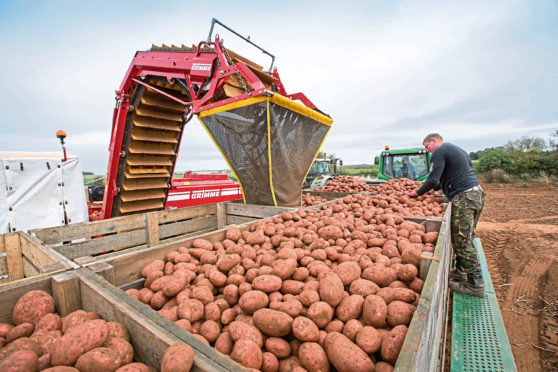I like potatoes. I mean, I’m not addicted to them or anything, but I am Highland enough to know that a dinner without potatoes is no dinner at all.
They’re best when floury, boiled and mashed with butter.
Apparently, the potato was first domesticated in the region of modern-day southern Peru and north-western Bolivia between 8,000 and 5,000 BC, and introduced into Europe in the second half of the 16th century by the Spanish.
The Statistical Account of Scotland tells us that they were first cultivated near Stirling in 1739, and were not known in the Highlands until 1743 when introduced to my native South Uist by the then clan chief, Clanranald. Not that the people fancied it.
It’s recorded they said: “Faodaidh Mac ’Ic Ailean toirt oirnn an cur, ach a Mhuire, cha toir e oirnn an ithe” – Clanranald can certainly force us to plant them, but by the Holy Mother, he can’t force us to eat them!
Throughout Europe the potato was at first regarded with suspicion and dislike, and used only as animal fodder and sustenance for those who were literally starving.
They were alien and mis-shapen things – compare them to the perfect roundness of an orange or the shiny redness of an apple, for example.
But soon enough the potato became an essential part of our diet.
It was easy and cheap enough to grow in vast quantities and was central (along with bread and ale) in feeding thousands upon thousands as the Industrial Revolution developed.
As more and more people left the countryside for the cities, wagons filled with endless sacks of potatoes followed them in to feed them all.
It also became the staple diet in both rural Scotland and Ireland, where millions of people came to depend heavily on it for their everyday sustenance.
To their ultimate cost when the tragic potato blight and famine struck both nations in the 1840s.
It’s estimated that more than a million people died in Ireland between 1846 and 1850 as a result of the potato famine (some historians put the estimate as high as five million), with another million emigrating as a result of the ensuing starvation, landlessness and poverty.
And what a terrible indictment on our own day and age and politics that it was revealed this week that almost 2,500 children in England have been admitted to hospitals with malnutrition in the first six months of this year.
Here in the Scottish Highlands the 19th-century potato famine took a terrible toll, with up to 200,000 people seriously at risk and causing massive emigrations from the north-west Highlands in particular.
It is estimated that about a third of the population of the western Scottish Highlands emigrated and moved between 1846 and 1861 – many of those, including some of my own ancestors who were cleared from the green pastures of Corodail at the north end of South Uist to the rocky shores of the east and south, to make way for sheep.
The other thing I always remember about the history of the potato is how, when the press gangs came to the Gaidhealtachd, they often approached the lads working the potatoes on the machair, their hands extended in greeting.
When the potato-grower shook the soldier’s hand he found the king’s shilling in it, and off he went to the wars.
Since those sorry days the potato has become a varied dish. You can have them boiled or mashed or fried or baked or roasted or hashed or pancaked or wedged or gnocchied or croquetted or waffled or omeletted or fondanted or… och, stop it, that’s enough, just wash them and clean them and boil them and mash them and add a wad of butter and that’s it.
Oh, and there’s that dreadful packeted stuff – Smash! Do they still make it? Powder in a pack, add boiling water and stir. For mash get Smash!
Then there are the varieties. There are apparently more than 4,000 varieties of potato throughout the world, though only around 80 kinds are grown commercially.
You only get a few varieties in the average supermarket, so if you want to become a potato aficionado you should look far and wide to specialists who grow these different types.
Apparently there’s a type of potato called Highland Burgundy and one called Shetland Black and the Dunbar Rover, which was first bred in 1936 by Charles T Spence of Tynefield Farm.
It’s a floury tattie, which is best. Just like my all-time favourite, which are the dry tatties grown on the machair in South Uist.
Once you taste these you can never eat, with any pleasure, those tasteless and soggy wet potatoes you sometimes get from the shop.
The machair tatties are best boiled in their skins until their jackets begin to peel off.
Once you’ve drained the boiling water away and you add the salted butter, you won’t need anything else to go with it, unless it’s a sgadan (herring) or an organic heather-bred lamb chop from any of the splendid local crofts and farms in The Press and Journal area.
Angus Peter Campbell is an award-winning writer and actor from Uist










